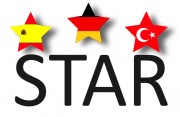Presentation of the groups mind maps: some groups orientated at the aspects social, economics, environment and politics concerning to the forms of energy like biogas and solar on side of the renewable energys or coal and uranium on the side of conventional energy. There were also listed pro and contra for each energy form, see mind maps.
Presentation of the autarky energy plan of the county Steinfurt. In cooperation with the university of Münster Steinfurt trying to produce and use 100% renewable energy for their city until 2050. They are financially supported by programs of the EU and of the german state of NRW:
http://agenda21.kreis-steinfurt.de/C12574240047C747/html/E7D842C442CE7B57C12576F70045068A?open document
Discussion in groups about what we learned so far, discussion of still existing questions, inventing slogans about improving situation of energy production and consumption:
Work together – energy transition is a big task. It´s not up to one person, but to the whole world.
More investment and research in renewable energy for the future – energy for thinking doesn´t cost a thing.

Slogan:
Group 1.
1. Renewable energy resources is a key of a healthy future.
2. Petrol runs out, coal runs out, solar-hydro and wind is enough for us.
3. Give up dipping soil, look at the sky.
Group 2.
1.leave your car, take your bike.
2.let’s renew the energy.
Group 3.
1. Mind energy is free.
2. Renewable energies, renewal life.
3. We don’t need more energy, we just need more awareness.
 Mr. Richter- Warendorf District:
Mr. Richter- Warendorf District:
Climatology and energy expert. He works as energy consultant in a company and he is the only person who works in the district. He has been in 65 different projects. Local managements which are in this area compete each other to change their systems with renewable energy, and it has managements which are selected by the help of elections. Before starting a project, energy potential in this area is detected and calculated. From the coming of sunlight angle to affect of wind, everything is calculated. The biggest problem is that if you try to store the without using it, a huge amount of energy loss is experienced. He also briefed about the potential of this area.
 Mrs. Huth – municipal energy supplier ( German stadtwerke )
Mrs. Huth – municipal energy supplier ( German stadtwerke )
She works at the company which has business organization in the city municipality. She gave us some information about the construction of wind energy mills and made us watch a video which was about it. Then, she was asked questions by the participants. For instance; how much does it cost?, the height of windmills and how it works after being constructed, and also is sustainable energy sustainable? After the lecturer answered the questions, the class dismissed.
Afterwards, participants started to deal with ” Internet and press research on the perception of Germany’s energy transition in national and international press”. Then, students were split up into four different international groups and requested to come up with a question and answer about what we had seen throughout the previous week.
At 4.30 pm, the class finished.
After the too much rain.



Ali DEMIRCI
Christian DREISSIG














 Mr. Richter- Warendorf District:
Mr. Richter- Warendorf District:  Mrs. Huth – municipal energy supplier ( German stadtwerke )
Mrs. Huth – municipal energy supplier ( German stadtwerke )












